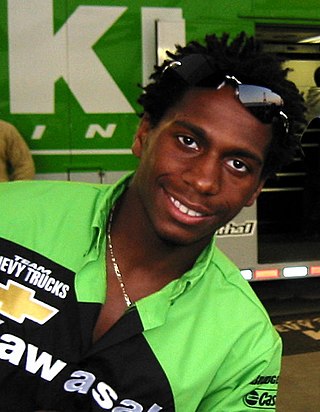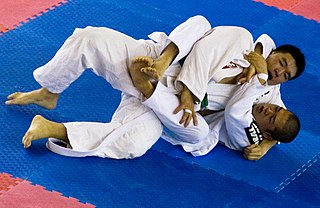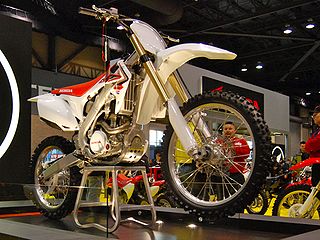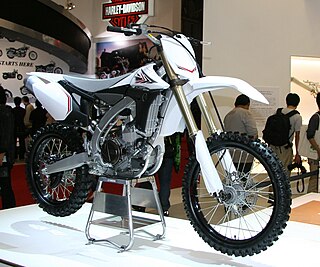Related Research Articles

The Wankel engine is a type of internal combustion engine using an eccentric rotary design to convert pressure into rotating motion. The concept was proven by German engineer Felix Wankel, followed by a commercially feasible engine designed by German engineer Hanns-Dieter Paschke. The Wankel engine's rotor, which creates the turning motion, is similar in shape to a Reuleaux triangle, with the sides having less curvature. The rotor spins inside a figure-eight-like epitrochoidal housing, around a fixed-toothed gearing. The midpoint of the rotor moves in a circle around the output shaft, spinning the shaft via a cam.

To improve motorcycle safety, many countries mandate the wearing of personal protective equipment such as protective clothing and helmets. Protective clothing may include certain types of jackets, gloves, boots, and pants. Jackets meant for motorcyclists are typically made of leather or specialized man-made fabrics like cordura or Kevlar. These jackets typically include padding on the elbow, spine, and shoulder regions. This was once quite bulky, but modern technology and materials have made it unobtrusive. Gloves are generally made of leather or Kevlar and some include carbon fiber knuckle protection. Boots, especially those for sport riding, include reinforcement and plastic caps on the ankle and toe areas. Pants are usually leather, cordura, or Kevlar. Except for helmets, none of these items are required by law in any state in the USA, or in any part of the UK but are recommended by many of those who ride.

Mountain biking is a sport of riding bicycles off-road, often over rough terrain, usually using specially designed mountain bikes. Mountain bikes share similarities with other bikes but incorporate features designed to enhance durability and performance in rough terrain, such as air or coil-sprung shocks used as suspension, larger and wider wheels and tires, stronger frame materials, and mechanically or hydraulically actuated disc brakes. Mountain biking can generally be broken down into five distinct categories: cross country, trail riding, all mountain, downhill, and freeride.

Motocross is a form of off-road motorcycle racing held on enclosed off-road circuits. The sport evolved from motorcycle trials competitions held in the United Kingdom.

Altitude diving is underwater diving using scuba or surface supplied diving equipment where the surface is 300 metres (980 ft) or more above sea level. Altitude is significant in diving because it affects the decompression requirement for a dive, so that the stop depths and decompression times used for dives at altitude are different from those used for the same dive profile at sea level. The U.S. Navy tables recommend that no alteration be made for dives at altitudes lower than 91 metres (299 ft) and for dives between 91 and 300 meters correction is required for dives deeper than 44 metres (144 ft) of sea water. Most recently manufactured decompression computers can automatically compensate for altitude.

X-Treme Sports was a Canadian English language category 2 television channel owned by Canwest Media Inc., a division of Canwest Global Communications. X-Treme Sports aired a variety of programming primarily related to extreme sports.

James Stewart Jr., also known as Bubba Stewart, is an American former professional motocross racer who competed in the AMA Motocross Championship and the AMA Supercross Championships. Through his years of racing, he earned the nickname "The Fastest Man on The Planet".
In software development and product management, a user story is an informal, natural language description of features of a software system. They are written from the perspective of an end user or user of a system, and may be recorded on index cards, Post-it notes, or digitally in specific management software. Depending on the product, user stories may be written by different stakeholders like client, user, manager, or development team.

In combat sports, a spinal lock is a multiple joint lock applied to the spinal column, which is performed by forcing the spine beyond its normal ranges of motion. This is typically done by bending or twisting the head or upper body into abnormal positions. Commonly, spinal locks might strain the spinal musculature or result in a mild spinal sprain, while a forcefully and/or suddenly applied spinal lock may cause severe ligament damage or damage to the vertebrae, and possibly result in serious spinal cord injury, stroke, or death. Spinal locks and cervical locks are forbidden in IBJJF Brazilian jiu-jitsu competitions, amateur mixed martial arts (MMA), multiple forms of no Gi jiu-jitsu, judo, and other martial arts. However, professional MMA and some Brazilian jiu-jitsu competitions do permit spinal locks and, particularly, neck cranks, and such moves are trained in various MMA and Brazilian jiu-jitsu schools.

The Honda CRF series is a line of four-stroke motocross, trail, and dual sport motorcycles manufactured and marketed by Honda.
ATK is an American motorcycle and all-terrain vehicle company founded in 1985 and located in Centerville, Utah, USA. As of 2016, it has been operating primarily to support previously sold models through parts and service manual distribution. While ATK was initially founded on in-house chassis designs and modified sourced engines, the brand has primarily focused on acquisition and badge-engineered models from multiple companies worldwide since 2004.

The Advanced Combat Helmet (ACH) is the United States Army's current combat helmet, used since the early 2000s. It was developed by the United States Army Soldier Systems Center, the U.S. Army Special Operations Command, and the U.S. Army Research Laboratory to be the next generation of protective combat helmets for use by the American ground forces. The ACH is derived from the Modular Integrated Communications Helmet.

Rollkur or hyperflexion of the horse's neck is defined as "flexion of the horse's neck achieved through aggressive force" and is banned in International and Olympic sanctioned equestrian sports by the governing body, the International Federation for Equestrian Sports (FEI). The FEI recognises a distinction between rollkur and the riding of the horse in a deep outline not achieved by force.

The Nordenfelt gun was a multiple-barrel organ gun that had a row of up to twelve barrels. It was fired by pulling a lever back and forth and ammunition was gravity fed through chutes for each barrel. It was produced in a number of different calibres up to 25 mm (0.98 in). Larger calibres were also used, but for these calibres the design simply permitted rapid manual loading rather than true automatic fire. This article covers the anti-personnel rifle-calibre gun.
The AMA Motocross Championship (commercially known as Pro Motocross Championship) is an American motorcycle racing series. The motocross race series was founded and sanctioned by the American Motorcyclist Association (AMA) in 1972. The series is the major outdoor motocross series in the United States and is sanctioned by AMA Pro Racing and managed by MX Sports Pro Racing.

Fox Racing is an American extreme sports, protective equipment, and lifestyle-clothing brand founded in 1974. Fox is owned by Vista Outdoor.

The Yamaha YZ450F is a four-stroke racing motocross bike built by Yamaha Motor Corporation. It was the successor to the previous YZ426F which was discontinued in 2003. It is credited by Cycle World and Dirt Rider magazines as the bike that started the four-stroke dirt bike revolution. The 2006 YZ250F and YZ450F were the first production motorcycles equipped with titanium suspension springs.

Orthotics is a medical specialty that focuses on the design and application of orthoses, sometimes known as braces or calipers. An orthosis is "an externally applied device used to influence the structural and functional characteristics of the neuromuscular and skeletal systems." Orthotists are professionals who specialize in designing these braces.

The following outline is provided as an overview of motorcycles and motorcycling:
Mark Bly is an American dramaturge, educator, and author. After graduating from Yale's Dramaturgy and Dramatic Criticism Program in 1980, Bly worked as a resident dramaturge – then a relatively new position in the United States. He held this position for several of the country's major regional theaters: the Guthrie, Yale Rep, Seattle Rep, Arena Stage, and the Alley. He was the first dramaturge to receive a Broadway dramaturgy credit for his collaboration with director Emily Mann on her play Execution of Justice (1986), During his career, Bly worked as a production dramaturge with a series of major theater artists including Doug Hughes, Garland Wright, Emily Mann and Moisés Kaufman, as well as on the world premieres of works by playwrights Suzan-Lori Parks, Sarah Ruhl and Rajiv Joseph.
References
- ↑ Cornel Stan and co-authors (2007). Development trends of motorcycles 3. With 10 tables. Renningen. ISBN 978-3-8169-2752-5. OCLC 182724963.
{{cite book}}: CS1 maint: location missing publisher (link) - ↑ "Leatt Corporation" . Retrieved 3 October 2012. Apparel worldwide.
- ↑ Leatt History. Retrieved July 10 2016. http://leatt-corp.com/leatt-history/
- ↑ Neural tissue biomechanics. Lynne E. Bilston. Berlin: Springer. 2011. pp. 175–177. ISBN 978-3-642-13890-4. OCLC 755574352.
{{cite book}}: CS1 maint: others (link) - ↑ Paton, Simon. "Leatt Neck Braces - THE REVIEW YOU MUST READ". PinkBike.com. Retrieved 26 November 2012.
- ↑ Wong, Derryn. "The Leatt Moto GPX Club Neck Brace". WebBikeWorld.com. Retrieved 11 May 2012.